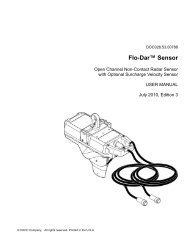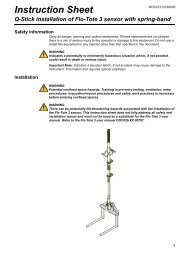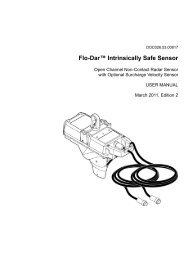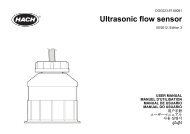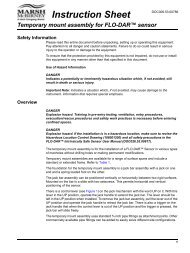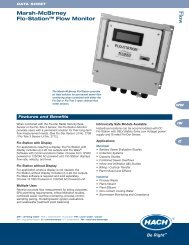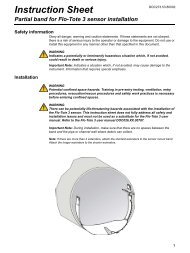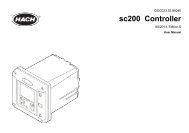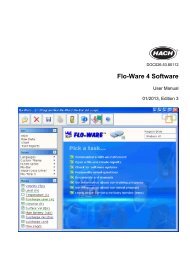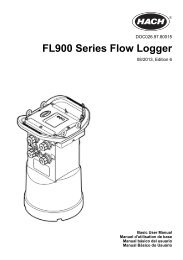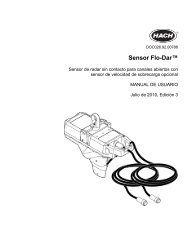FH950 User Manual English - Hachflow
FH950 User Manual English - Hachflow
FH950 User Manual English - Hachflow
You also want an ePaper? Increase the reach of your titles
YUMPU automatically turns print PDFs into web optimized ePapers that Google loves.
For example, after measurements have been done at 10 stations, a user may wish to insert a new<br />
station between stations 3 and 4. The steps below describe how to do this. These steps can be<br />
applied in similar situations.<br />
1. Select Prev and push OK until the display shows the information for Station 3.<br />
2. Select Ins and push OK.<br />
The instrument adds a new station named Station 4. Subsequent stations are automatically given<br />
new sequential numbers.<br />
3. To delete the current station (when in non-fixed mode), select Del and push OK.<br />
Conduit profiles<br />
It is possible to use all of the methods for conduit profiles in this section in sites with a typical profile<br />
shape and sufficient depth to measure 3-point velocities. The 0.9 x Vmax method can also be used<br />
when the depth is not sufficient for multi-point profiles.<br />
Note: In typical conduit profiles, the first measurement is made at the bottom. Subsequent measurements are<br />
made above the one made before. A different procedure may be necessary for some profiles.<br />
1. In the Main Menu, select Profiler.<br />
2. Enter the operator name.<br />
3. In the list of options, select Conduit.<br />
4. Enter a name for the new Conduit profile.<br />
5. Select the conduit shape.<br />
Note: The input screens that show next depend on the shape selected.<br />
6. Enter values at the screen prompts.<br />
When the necessary values have been entered, the display shows the Select Method menu.<br />
7. Select a profile method and do the steps for the method.<br />
Option<br />
Description<br />
0.9 x Vmax The meter calculates flow based on 90% of the fastest velocity. This is the recommended<br />
method when the depth is less than 12.7 cm (5 in.) or when the velocity is not stable.<br />
0.2/0.4/0.8 The meter calculates the flow value based on velocity measurements taken at 0.2, 0.4 and<br />
0.8 x the depth. One and two-point versions of this method are also possible.<br />
Vel./Lev. Integ.<br />
The meter integrates 10 separate velocity and level measurements to calculate the flow<br />
level.<br />
2D<br />
The sensor collects information while constantly moved through the flow in a specified<br />
pattern. The meter calculates the flow value when the user selects Save. This method is<br />
recommended for flows where a difference of 30% or more exists between the right and left<br />
side velocities.<br />
0.9 x Vmax measurement method<br />
The meter uses the maximum velocity measurement in the conduit and multiplies this value by 0.9 to<br />
calculate the total flow.<br />
Note: The RC filter mode with a value of 2 to 4 seconds is recommended for this method.<br />
1. In the Select Method menu, select 0.9 x Vmax.<br />
2. With the sensor in the flow, select Measure Velocity to get a velocity measurement.<br />
The measured values are shown on the graph.<br />
3. Move the sensor until a point of maximum velocity is found, then push OK.<br />
The meter calculates and shows the flow, maximum and average velocity values.<br />
4. Select Save.<br />
The information is saved to a data file.<br />
22 <strong>English</strong>



